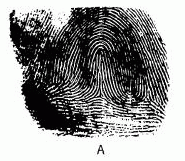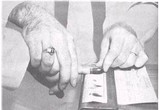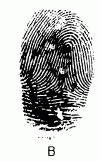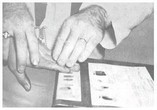Steps in Taking Fingerprints
To help you obtain the best set of fingerprints possible, use the following procedures:
Initial steps. First, have the subject sign the fingerprint card. Next, have the subject wash his or her hands to remove any dirt particles. Ensure that the fingers are free of lint from towels used to dry the hands.
Inking. The ink and glass or stainless steel method, as well as fingerprint pads, as well as the inkless system are the most common. The mechanics of rolling fingerprints is the same for all three methods. Whichever method is used, insure the ink is spread evenly over the surface.
The ink and glass or stainless steel method, as well as fingerprint pads, as well as the inkless system are the most common. The mechanics of rolling fingerprints is the same for all three methods. Whichever method is used, insure the ink is spread evenly over the surface.
Rolled impressions. Rolled impressions (fig A, below) are made by rolling the finger or thumb from nail edge to nail edge. They are made to show the entire friction surface of the finger or thumb, from the tip to one quarter inch below the first joint. The larger surface of the fully rolled impression not only allows accurate classification but it also gives more points for comparison.
Important! Ensure the print does not cover or extend beyond the blue lines of the box. The entire print must be within the confines of the box. This may require that less surface of the finger be rolled for persons with large fingers.
There is a specific method of rolling the subject's fingers or thumbs in the ink and onto the fingerprint card to ensure a good impression. The basic premise is to roll the fingers or thumbs from awkward to comfortable.
To illustrate this, hold your hands in front of you with the backs of your hands together. Now roll them around so that the palms are together and the thumbs are up. You will see that the right hand moved clockwise and the left hand moved counterclockwise. This is the direction the fingers on each hand should be moved. Thumbs are moved in the opposite direction of the fingers.

The person taking the prints should grasp the top of the subject's hand and ensure that the finger to be printed is extended. The roll is a single movement with only enough pressure to provide a clear print. The subject being printed should be told to look away from the fingerprint card and to try not to "help" the roll. This will reduce smudging and produce a clean impression.

Plain impressions. Plain impressions (fig. B, below) are made on the card by simply pressing the four fingers on it at a slight angle. They should be showing the tips to one-quarter inch below the first joint. Thumbs are then printed by simply re-inking and pressing them on the block next to the plain finger impressions. The purpose of plain impressions is to verify the order of the rolled impressions and to show certain characteristics that are sometimes distorted in the rolled prints.

The subject's fingers are held straight and stiff. The hand should be level with the wrist. The person taking the prints should grasp the wrist with one hand and press the fingers onto the cards with the other hand.

Final step. After the printing procedure is completed, the person taking the prints should complete the information on the fingerprint card. Lay a sheet of paper towel over the prints before placing your hand on the card to enter information. There should be facilities nearby for the subject to clean the ink from the fingers.
PROBLEM PRINTS
Mistakes. If a mistake is made, do not cross out the bad print and then re-roll the print on the back of the card. Instead, use a tab over and re-roll the print in the proper place on the front of the card.
Dry or soft skin. Certain people have dry and rough hands because of their occupations. Rubbing the tips of the fingers with oil or creams will often make the fingers pliable and soft enough for clear, unsmudged prints to be made. Holding ice against the fingers will sometimes help if the ridges are fine and small and the skin is soft-as is often the case with children or women.
Deformed fingers or hands. If the hands and fingers are so deformed that the regular printing procedure cannot be followed, prints can be made by applying the ink directly to the fingers with a spatula or small roller. A square, self-sticking replacement tab can be rotated around the finger. When a satisfactory print has been made, this square is then affixed to the appropriate box of the fingerprint card.
In cases where there are extra fingers (usually little fingers or thumbs), the innermost five are printed on the card, and the extra digit is printed on the reverse of the card.
Webbed fingers are printed as well as possible in the roller and plain impressions.
Make a notation if a finger or fingertip is amputated (or has some other deformity) in the appropriate box on the card specifying which finger is deformed. (Example: "AMP, LEFT INDEX, 1ST JOINT, FEB 1943" or "LEFT INDEX TIP AMP" or "BEST PRINTS POSSIBLE"). Ensure that the writing stays within the appropriate box.
The fingerprint card classification system for Licensing is automated now and the prints are either acceptable or rejected by the FBI, which are then returned to the applicant by DPS. Returned print cards require submission of a new set of prints by the applicant within a specified time frame. Failure to resubmit the card can result in the suspension of the applicant's license.
Excessive perspiration. Because of the subject's excessive perspiration, some inked impressions will be indistinct. Wipe each finger with a cloth and immediately ink and roll the finger on the fingerprint card. Follow this process with each finger. It is also possible to wipe the fingers with alcohol or similar fluid that would act as a drying agent.
POOR IMPRESSIONS
Poor impressions usually are caused by one or more of the following mistakes:
- The use of poor, thin, or colored ink resulting in impressions too light or too faint or with obliterated ridges. Best results are obtained by using heavy, black printer's ink. This is a paste, and it should not be thinned before using. It dries quickly and does not blur or smear in handling.
- Failure to clean the person's fingers thoroughly before inking. If foreign matter (or perspiration) adheres to the fingers, false markings appear and characteristics disappear.
- Failure to clean the inking apparatus after each use.
- Failure to roll the fingers fully from one side to the other and failure to ink the entire finger area from tip to below the first joint. Such failures result in important areas not appearing on the print. The impression should show the entire finger, from the first joint to the tip, and from one side to the other side.
- The use of too much ink, resulting in the obliteration of ridges. Just a touch of the tube of ink to the plate is sufficient for several sets of prints. It must be spread with a roller into a thin, even film.
- The use of too little ink, resulting in ridge impressions too light and too faint for tracing or counting. If light or faint impressions occur when using a porelon pad the pad needs to be replaced.
- Slipping or twisting of the fingers, causing smears, blurs, and false patterns. Hold the fingers lightly, using little pressure, and caution the person against trying to help. Ask him or her to remain quiet and relaxed.
Any questions call 800.969.6699 or email us at Sales@HittMarking.com